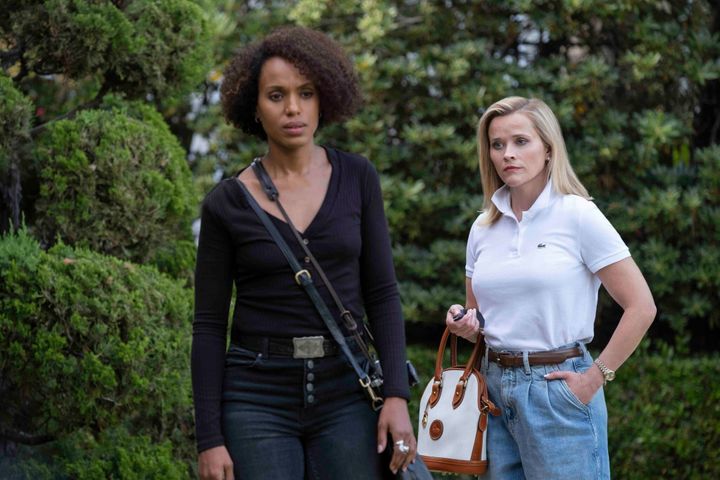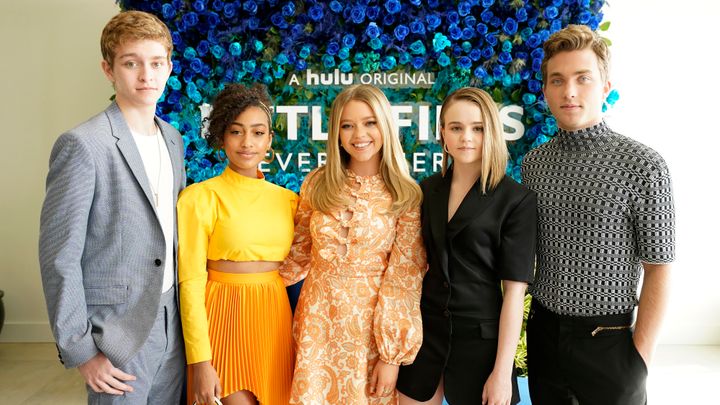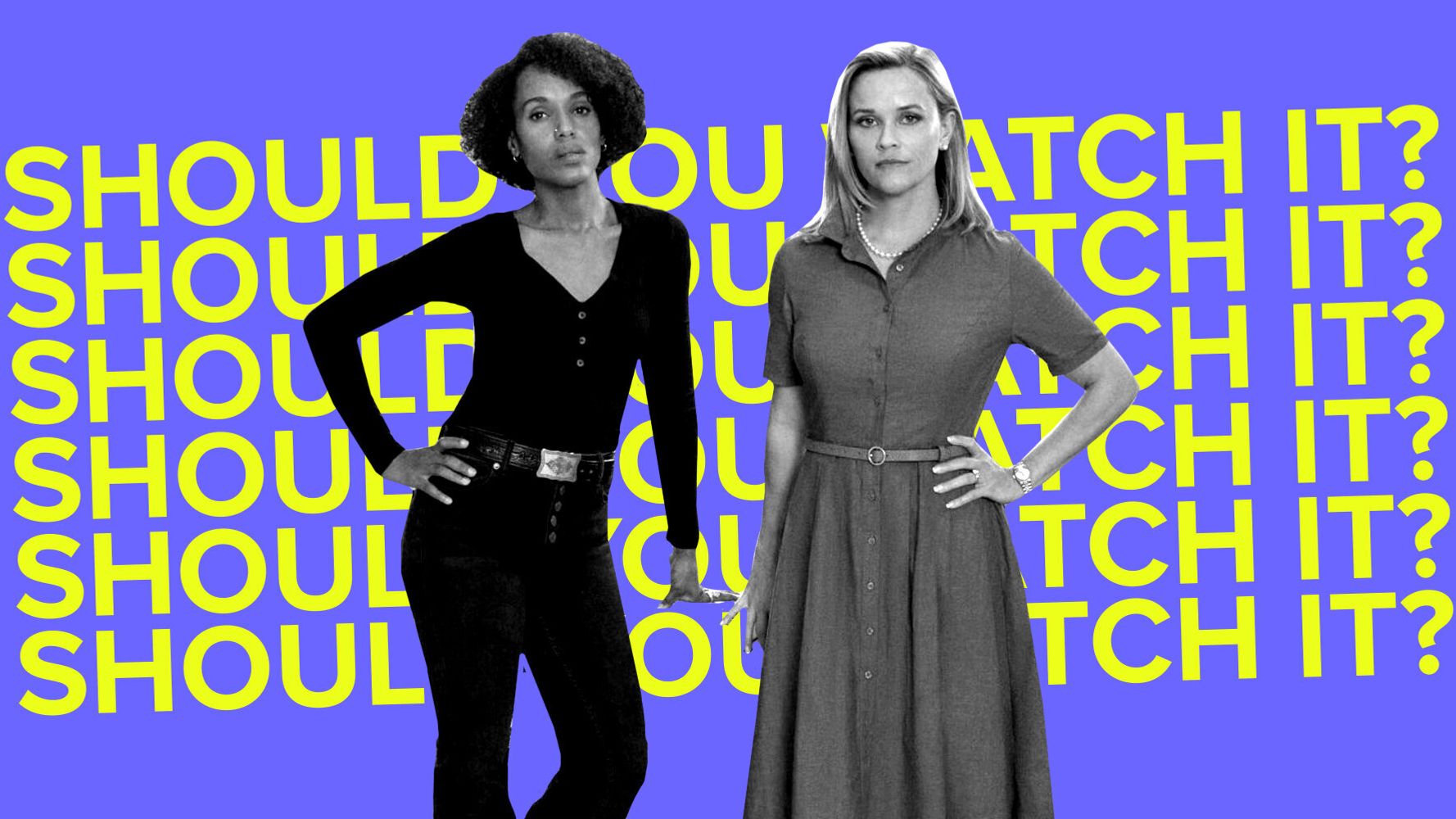[ad_1]
As we’re all, hopefully, social distancing and staying quarantined in our homes amid the coronavirus outbreak, there’s only one thing to look toward: new TV series to binge-watch. (Also, the safety and well-being of the human race, but you get it.)
“Little Fires Everywhere,” which debuted on Hulu Wednesday with a three-episode dump, might be a contender. The show, based on Celeste Ng’s stellar 2017 novel of the same name, stars Reese Witherspoon and Kerry Washington as Elena Richardson and Mia Warren, respectively ― two mothers on opposite sides of the tracks in the predominantly white, highly privileged suburb of Shaker Heights, Ohio. Elena, a working mother of four teens, lives a seemingly idyllic life: She’s beautiful, married to a wealthy lawyer (Joshua Jackson) and maintains a job as a local reporter. Single mother Mia, on the other hand, is new to town. She is an artist and part-time waitress who takes up residence in Elena’s vacant apartment and soon becomes her house manager to make ends meet.
The women end up ensnared in conflict when it’s revealed that Elena’s friend Linda McCullough (Rosemarie DeWitt) is unknowingly adopting the baby of Mia’s co-worker Bebe Chow (Lu Huang), a struggling Chinese immigrant who abandoned her daughter, May Ling/Mirabelle, at a firehouse in a moment of desperation.
The story examines motherhood in all its forms, and the lengths we go to protect the ones we love.
The Bottom Line
Hulu’s adaptation of “Little Fires Everywhere” is an off-kilter soap-opera-like retelling of a remarkable and heartbreaking story about motherhood and identity. The subtlety of Celeste Ng’s story is lost in the performances.

From The Page To The Screen
Leigh Blickley: Erin, we both read Celeste Ng’s “Little Fires Everywhere” and loved it. Then, we watched Hulu’s “Little Fires Everywhere” and, well, we’re disappointed. Let’s get into it.
Erin Evans: Yes, I thought the book was very well-written and we really got to know the characters, and then the series just … amplified the drama times 10 to the point where some of the storylines were just implausible.
Of course, the biggest thing for me is that the book never described the race of Kerry Washington’s character, Mia Warren, which made me assume that she was white. There are plotlines that totally become more complicated — and sometimes straight-up racist —with a Black actress as Mia. But of course, I can see why for a television show set in the ’90s — and with today’s desire for more diversity on television — you’d want that race and class dynamic to be very clear.
LB: Of the decision to make Mia white in the book, Ng, an Asian-American, told Asia Society, “I’ve grown up in white communities my whole life, and like most people of color in the United States, I have a pretty good understanding of what it’s like to be white in America — so I feel comfortable writing characters who are white. On the other hand, I don’t claim to know what it’s like to be Black in America. I can imagine some aspects of it, but I don’t feel I know that experience well enough to write about it.”
The writers’ room for the show ― which includes Ng, showrunner Liz Tigelaar, Raamla Mohamed and Nancy Won ― clearly felt they had the representation to push the storylines further by casting Washington and Lexi Underwood as Mia’s daughter, Pearl. By doing that, everything seems a bit more heightened, especially when it comes to the dynamic between Mia and Reese Witherspoon’s character Elena Richardson.
As you mentioned, they do examine identity, and through a ’90s lens, but do you think it works well? I, for one, think it changes many aspects of the relationships and characters from the novel in interesting ways.
EE: I don’t think the timing of the novel changes much about the relationships. Lexie has a Black boyfriend, Brian, in the book and show, and their relationship is seemingly more fraught in the TV series because there’s more of a lens into how he thinks about Lexie’s whiteness (and her relationship to Black people). I think that kind of dynamic is just about as relevant in the ’90s. Then, of course, seeing Elena call the cops on two Black people sleeping in their car outside her office definitely resonates today amid Permit Patty and BBQ Becky calling police on Black people across the country. It’s set in the ’90s, but could be happening right now, too.
LB: Completely. And yes, Lexie and Brian’s relationship definitely changed drastically from book to screen, as did others.
What I love about Ng’s book is how nuanced it is. I turned each page gripped by the storytelling, especially because she writes through every character’s viewpoint, leading you to feel you truly know each of them and what they believe and feel in major moments. By the end of the novel I was rooting for all of these people in some way as I came to understand the values they possessed. With the show, I’m finding it harder to look past the melodrama and see the deeper purpose of the story.
How Do The Performances Measure Up?
EE: I agree with that 100%. It was so melodramatic, and a lot of that I’d put on the lead actresses. Both Kerry Washington and Reese Witherspoon were over-the-top dramatic with a capital D. I mean, we both had to stop watching after the first episode to get a feel for the book, to see how it matched up to the series. I thought the kids were fine actors though, and it’s kind of amazing how much the Richardson children actually look like they could be related in real life. What’d you think of the performances?
LB: They’re mini Reese Witherspoons and Joshua Jacksons! (Pacey Witter Jackson, might I add, is great in this and also looks great in tighty whities.) As for my favorite performer on the show so far, it would have to be Megan Stott, who plays Elena’s “troubled” daughter, Izzy. She’s earned my attention.
And I’m behind you on the leading ladies ― their performances are a bit excessive. It feels less premium content and more network soap? I also can’t picture Washington as anyone but Olivia Pope, which is my problem, and Witherspoon is playing a ’90s version of her “Big Little Lies” character, Madeline Mackenzie, which doesn’t help either. Both are talented actors, no doubt, but their star power doesn’t save the series. My hot take: Witherspoon is doing a tremendous job greenlighting and producing book-to-screen adaptations, but I feel she could step aside every once in a while when it comes to starring in them. Now that predicted limited series like “BLL” and “The Morning Show” have turned into more seasonal fare, she’s balancing a lot of character arcs.
EE: Yeah, I just kept imagining if they’d casted some lesser-known names for the leading ladies, and if that might have made for a better watching experience. And I’ve loved Reese Witherspoon since “Freeway,” but this performance just wasn’t doing it for me. And Washington’s lip quiver is too much. Later in the series, Tiffany Boone (“The Chi,” “Hunters”) and AnnaSophia Robb (“The Carrie Diaries”) portray younger versions of Mia and Elena. I love both of those actresses, and think they do a great job in the series.

The Question Of Motherhood
EE: Of course, the main storyline that does carry over from the book to the novel more seamlessly (in some ways) is that of Mia’s coworker Bebe Chow, who had left her child at a fire station and the baby is ultimately adopted by Elena’s friend, Linda McCullough. What’d you think of how that all translated from book to screen?
LB: Back to the nuance argument … Bebe’s storyline is so powerful in the book and makes you ruminate not only on the measure of motherhood but of love in general. Both Bebe and Linda have a case for why they deserve to be the legal guardian of May Ling/Mirabelle. They both adore her. They both want what’s best for her. One is her biological mother, one has raised her to her first birthday. But ultimately the court ― plus the gossipy townsfolk of Shaker Heights ― gets to decide who the rightful parent is. It’s heartbreaking and twisted and complicated and, described in Ng’s words, beautiful.
On the show, the adoption scandal is simply used as a plot device. All the connective tissue between Bebe and Mia is shoved in our faces rather than revealed eloquently. It’s maddening.
EE: There’s no subtlety in the show. At one point, Bebe screams bloody murder in the middle of May Ling/Mirabelle’s birthday party and it is a stark contrast to how it is handled in the book when she first sees her baby again. But also, Mia’s character is so much more heavily involved in Bebe’s life than I remember in the book. It’s like she’s on a personal crusade to help Bebe get her baby back!
LB: Exactly! It’s done with such little care. Less is more. (I’m getting angrier by the minute.)
OK, we don’t want to spoil the premise too much for people, so let’s get to the crux of the piece.
So, Should You Watch It?
EE: If you loved the book, I say skip this adaptation.
LB: Yeah. I urge people to read the book, then decide. You can love one and judge the other.
“Little Fires Everywhere” is on Hulu.
Calling all HuffPost superfans!
Sign up for membership to become a founding member and help shape HuffPost’s next chapter
[ad_2]
Source link

